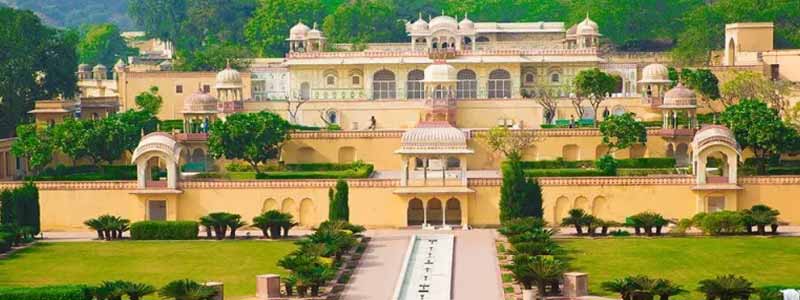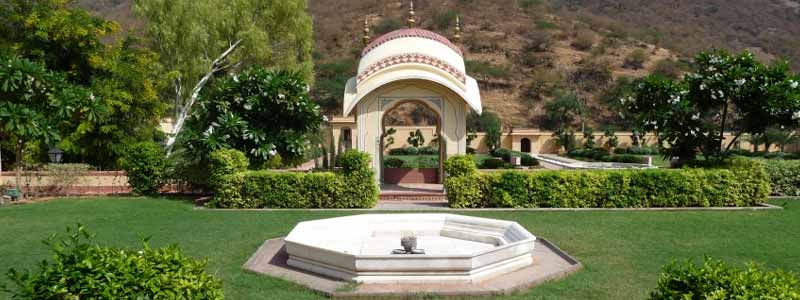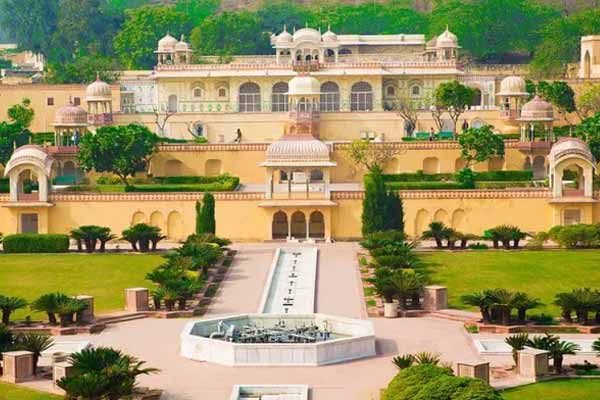Sisodia Rani Garden and Palace is a palace garden 6 kilometres (3.7 mi) from Jaipur city in of Rajasthan state in India. It was built by Maharaja Sawai Jai Singh II in 1728. The place consists of tiered multi-level gardens with fountains, watercourses and painted pavilions. A double-storeyed palace occupies the top terrace of the garden. The palace has many galleries, pavilions and beautiful murals depicting scenes from the life of lord Krishna. The palace lies on Jaipur Agara highway.
The palace garden derives its name, Sisodia Rani Garden and Palace, from the rani (queen) for whom it was built. She hailed from the Sisodia line of Suryavanshi (Sun dynasty) Rajputs, who ruled and now nominally rule the region of Mewar in Rajasthan.

History of Sisodiya Rani Garden
Sisodia Rani Ka Bagh was built by Maharaja Sawai Jai Singh in 1728 for his second queen, a princess from Udaipur. The Maharaja presented this royal garden to his beloved queen to serve as a perfect retreat place for her. Away from hustle bustle of court politics, the garden offered a peaceful haven for Sisodia Rani. The garden is filled with various plant species, lush green shrubs and scented flowers. The walls are decorated with murals of Radha-Krishna, symbolizing the love that the Maharaja had for his beloved queen Sisodia.
Sisodia Rani Garden and Palace is a beautiful palace garden 6 kilometres (3.7 mi) from Jaipur city in of Rajasthan state in India. It was built by Maharaja Sawai Jai Singh II in 1779. The place consists of tiered multi-level gardens with fountains, watercourses and painted pavilions. A charming double storeyed palace occupies the top terrace of the garden. The palace has many galleries, pavilions and beautiful murals depicting scenes from the life of lord Krishna. The palace lies on Jaipur Agra highway.This royal garden was built by Maharaja Sawai Jai Singh in 1728 for his second queen Sisodia.
Sisodia Rani Garden is adorned with beautiful wall paintings of Radha-Krishna love story. The paintings on the wall and the narrative details truly represent eternal love and befits the essence of this garden which itself is a symbol of love. This lush green royal garden is replete with flowerbeds, foliage, beautiful water fountains, pavilions, galleries, iridescent water channels and murals Jaipur Tour Packages.

Architectural Layout of Sisodia Rani ka Bagh Jaipur
The architectural layout of the Sisodia Rani Garden is mostly influenced by the Charbagh style of the Mughal gardens. The gardens are multi- layered with flower beds and fountains, typical of the Mughal gardens.
For those who are unaware of the Charbagh garden style, this was introduced by the Mughals (specifically Babur) after they invaded India. The Charbagh is a native Persian style of quadrilateral or four- part garden divided by walking paths, sometimes lined by water beds that intersect at central point. The principle of the quadrilateral garden design is taken from mentions in the Qur’an where Charbagh is intercepted as gardens of Paradise.
The Mughals and the Kachwaha rulers of Amber had great political association as well as family relationships as one of the Kachwaha princesses was married to the Mughal emperor Akbar. The Kachwahas also fought many wars alongside the Mughals leading the armies. This is one of the reasons for most of the architecture of Amber and Jaipur having Mughal influence.
The spires and pavilions of the Sisodia Rani Garden are frescoed with Hindu motifs and paintings from the life of Krishna and are built in Indian architecture. The Queen’s palace is placed in such a way that it overlooks the entire garden. The murals on the walls of the palace are majorly based on the love stories and legends from the lives of Lord Krishna and his most beloved Radha. In addition to the murals of Radha and Krishna, the palace walls also have murals and paintings of hunting scenes.
Another aspect of the well- planned architecture is that none of the staircases of the building are visible and appear concealed Jaipur Attractions.
There is a central shrine dedicated to the Hindu Gods like Lord Shiva, Lord Hanuman and Lord Vishnu. There is also a natural spring located beside the central shrine.
Places to visit near Sisodia Rani ka Bagh Jaipur
Galta Ji Temple: Experience history and divinity all at one place when you walk into the architectural marvel that is Galta Ji Temple, built between the crevice of two hills with natural springs and seven sacred kunds (water tanks). Visitors are highly recommended to pay a visit to Galta Ji, especially people interested in ancient history.
Vidyadhar Bagh: Located at a stone’s throw away from the Sisodia Rani Garden, the Vidyadhar Garden was built to pay tribute to the man who designed Jaipur, the first ever planned city of India – Vidyadhar Bhattacharya. Enjoy a peaceful afternoon away from the bustling city for free with the local delicacies from the snack corners lined outside the park.
City palace: Know where the royals live, because the palace still continues to be the home to the royal family of Jaipur. The whopping entry fee to the city palace is all worth spending when one gets to see the intricacies of the designs and the resplendent interiors, the courtyards and the Sawai Man Singh II Museum. This place is right fit for a history enthusiast.
Jantar Mantar: When the king is a mathematics and astronomy enthusiast, the city has to get infrastructure worthy to be listed under UNESCO World Heritage sites. Built by the founder of Jaipur, Maharaja Sawai Jai Singh II, the Jantar Mantar of Jaipur houses the world’s largest sundial. A visit here can be coupled with a visit to the Sisodia Rani Garden City Palace.
Hawa Mahal: The name of the pink sandstone palace literally translates to ‘Palace of Winds’. Walk up to the top of the palace through the circular staircase and feel that wind on your face and enjoy the view of the city down through the tiny little colourful windows.
Johari Bazar: If anyone is a sucker for artificial jewellery and other traditional artefacts, and got the bargaining gene, live your wish of ‘shop till you drop’ at the Johari Bazar.
Best Time to Visit Sisodiya Rani Garden
The garden is at prime beauty during winter season and early summer season. The winter season starts in October and ends in February. This is the time for pleasing walks, romantic strolls and other relaxing activities. However, during winter, you cannot find many flowers in the garden. The recent rains would have brought lush and greenery to the region. The blooming season starts in summer. March to April is the best time for enjoying flowers, photography and evening strolls.
How to Reach
You can get local buses that leave from Ghat Gate for the Sisodia Rani Garden. It is 10 km from Jaipur Railway station and 14 km from the airport which takes nearly half an hour to reach the garden.
